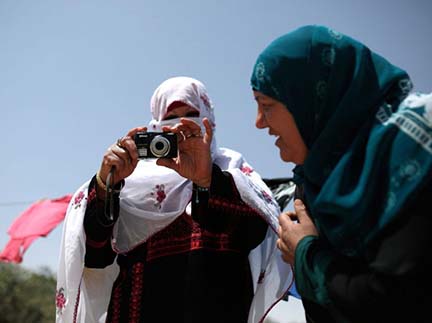
“Photography has brought us closer, it’s enabled us to find a common language.†Photo by Ilan Assayag
The reality exposed by Bedouin women armed with cameras
Mothers and daughters from unrecognized villages empowered through photography.
By Vered Lee, Haaretz,| May 13, 2015
Mahadia Abu-Joda, 53, a mother of 13 and resident of the unrecognized Bedouin village of Za’arura, cradles a red digital camera in her hand. “The first time in my life that I held a camera and prepared to take a picture, about a year and a half ago, I held it upside down and in the wrong direction,†she says through the hijab that conceals her hair and frames her face.
Abu-Joda’s photographs appear in one of the four recently published photography books that document life in four unrecognized Bedouin villages in the Negev from a feminine point of view: Za’arura, Atir, Wadi al-Na’am and Alsra. The books, which are accompanied by an exhibition on display at present at Multaka-Mifgash, a Jewish-Arab cultural center in Be’er Sheva, were produced by the Negev Coexistence Forum and created during a project operated by the organization Human Rights Defenders, in which about 30 Bedouin women from the unrecognized villages participated.
Abu-Joda was born in Gaza. At the age of 16 she married and moved to Za’arura, which is east of the town of Kseifa and today numbers about 2,600 residents. “About two years ago they demolished our home,†she says when asked why she started to photograph. “We didn’t have a place to sleep. I was among the ruins of the house with all my children. It was cold and rainy. I didn’t know what to explain to the children. I myself didn’t understand why the government did that to me. I didn’t know how to protect them. I was in despair. At the time a young girl passed and told me about the human rights project, explaining that we could learn our basic rights and preserve them by means of the camera and photography. Many of the women didn’t understand what she wanted and asked how it would help to photograph ruins. I was immediately attracted. I wanted to document the injustice done to me, I wanted to show everyone the situation in which we live.â€
Today Abu-Joda lives with her family in a hut made of patched sheets of iron and tin. “We haven’t been able to build a new house yet,†she says.
She leafs through the book and by means of the photos tells about the village residents’ living conditions: “There are no paved roads, no clinic, no kindergartens or schools. We don’t receive water and electricity from the authorities. Some of the people use solar panels and some use generators.â€
For the rest of the article and more photos, click here.